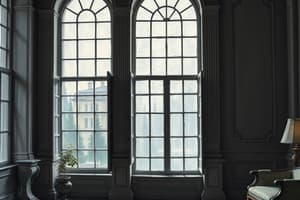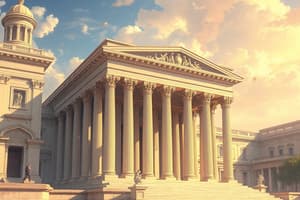Podcast
Questions and Answers
What architectural order does the Propileos of Munich utilize?
What architectural order does the Propileos of Munich utilize?
- Tuscan order
- Ionic order
- Corinthian order
- Doric order (correct)
Which feature is NOT associated with the Propileos of Munich?
Which feature is NOT associated with the Propileos of Munich?
- A dome (correct)
- Frontons
- Straight lines
- A portico
Who was the first Spanish architect to adopt the neoclassical style?
Who was the first Spanish architect to adopt the neoclassical style?
- Charles III
- Francesco Sabatini
- Ventura Rodríguez (correct)
- Juan de Villanueva
What significant structure did Francesco Sabatini design that symbolizes Madrid's urban transformation?
What significant structure did Francesco Sabatini design that symbolizes Madrid's urban transformation?
The design of the Propileos draws inspiration from which significant structure?
The design of the Propileos draws inspiration from which significant structure?
Which architectural feature stands out at the Prado National Museum's entrance?
Which architectural feature stands out at the Prado National Museum's entrance?
Which of the following is NOT mentioned as a neoclassical building in the document?
Which of the following is NOT mentioned as a neoclassical building in the document?
What architectural model did Juan de Villanueva adopt for the Astronomical Observatory?
What architectural model did Juan de Villanueva adopt for the Astronomical Observatory?
What type of architectural elements are prevalent in the Propileos and other neoclassical buildings?
What type of architectural elements are prevalent in the Propileos and other neoclassical buildings?
What was the role of King Charles III in the development of neoclassical architecture in Spain?
What was the role of King Charles III in the development of neoclassical architecture in Spain?
What is a key characteristic of Neoclassical architecture?
What is a key characteristic of Neoclassical architecture?
Which architect designed the church of Santa Genoveva, known later as the Pantheon, in France?
Which architect designed the church of Santa Genoveva, known later as the Pantheon, in France?
What feature is predominant in the facade of the church of the Madeleine designed by Pierre Vignon?
What feature is predominant in the facade of the church of the Madeleine designed by Pierre Vignon?
Which monument commemorates Napoleon's victories and has a single archway without columns?
Which monument commemorates Napoleon's victories and has a single archway without columns?
What influence did King Carlos III have on urban transformation in Spain?
What influence did King Carlos III have on urban transformation in Spain?
What architectural inspiration is noted in German Neoclassical art?
What architectural inspiration is noted in German Neoclassical art?
Which of the following features is NOT typical of Neoclassical architecture?
Which of the following features is NOT typical of Neoclassical architecture?
What notable feature does the Vendôme Column in Germany have?
What notable feature does the Vendôme Column in Germany have?
Flashcards
Neoclassical Architecture
Neoclassical Architecture
An architectural style that draws inspiration from ancient Greek and Roman architecture.
What is the Propileos?
What is the Propileos?
The Propileos of Munich is a neoclassical building modeled after the monumental entrance to the Acropolis in Athens, Greece.
Doric Order
Doric Order
A prominent architectural feature in the Propileos of Munich, the Doric order is characterized by its simple and sturdy columns and lack of ornamentation. It's a key element in ancient Greek temples.
Who designed the Propileos in Munich?
Who designed the Propileos in Munich?
Signup and view all the flashcards
Straight Lines and Simple Fronts
Straight Lines and Simple Fronts
Signup and view all the flashcards
Ventura Rodríguez
Ventura Rodríguez
Signup and view all the flashcards
King Charles III
King Charles III
Signup and view all the flashcards
Juan de Villanueva
Juan de Villanueva
Signup and view all the flashcards
Astronomical Observatory
Astronomical Observatory
Signup and view all the flashcards
Italian Architects
Italian Architects
Signup and view all the flashcards
What are frontons in neoclassical architecture?
What are frontons in neoclassical architecture?
Signup and view all the flashcards
What are the 'orders' in Neoclassical Architecture?
What are the 'orders' in Neoclassical Architecture?
Signup and view all the flashcards
What is a dome in Neoclassical Architecture?
What is a dome in Neoclassical Architecture?
Signup and view all the flashcards
What is a portico in Neoclassical architecture?
What is a portico in Neoclassical architecture?
Signup and view all the flashcards
What is the Pantheon in Paris?
What is the Pantheon in Paris?
Signup and view all the flashcards
What is the Arc de Triomphe in Paris?
What is the Arc de Triomphe in Paris?
Signup and view all the flashcards
What is a typical Neoclassical building in Germany?
What is a typical Neoclassical building in Germany?
Signup and view all the flashcards
Study Notes
Neoclassical Art in Spain
- Neoclassical style emerged in Spain due to the influence of the court.
- Juan de Villanueva was a key figure in introducing Neoclassicism.
- The style's presence is visible in several monumental structures, like the Prado Museum.
- The Prado Museum's facade is highly noticeable due to its significant length and rows of pillars.
- The presence of a grand portico and an elevated attic is evident, with a significant entryway.
- The use of several pillars and a cornice supports the museum's overall grandeur.
- The design employs a Greek cross plan.
- It embodies the classic model of a public building.
Neoclassical Architecture in France
- French Neoclassicism emerged during the later 18th and early 19th centuries.
- The style was highly influenced by ancient Greek and Roman traditions.
- Architects like Soufflot brought a renewed emphasis on the grandiosity and symmetry of historical styles.
- The Pantheon in Paris exemplifies this style with its massive scale and classical features.
Neoclassical Architecture in Germany
- German Neoclassicism developed distinct characteristics.
- One key aspect is the clear use of straight lines in building designs.
- The combination of Roman and Greek details creates a unique aesthetic.
- The use of an arch and reliefs are important.
- The Arc de Triomphe de l'Étoile showcases the grandeur and symmetry of the period's designs.
Studying That Suits You
Use AI to generate personalized quizzes and flashcards to suit your learning preferences.
Description
Explore the Neoclassical movement in both Spain and France, highlighting key figures like Juan de Villanueva and the architectural marvels like the Prado Museum and the Pantheon. Understand how ancient Greek and Roman influences shaped the monumental styles of these countries during the 18th and 19th centuries.





